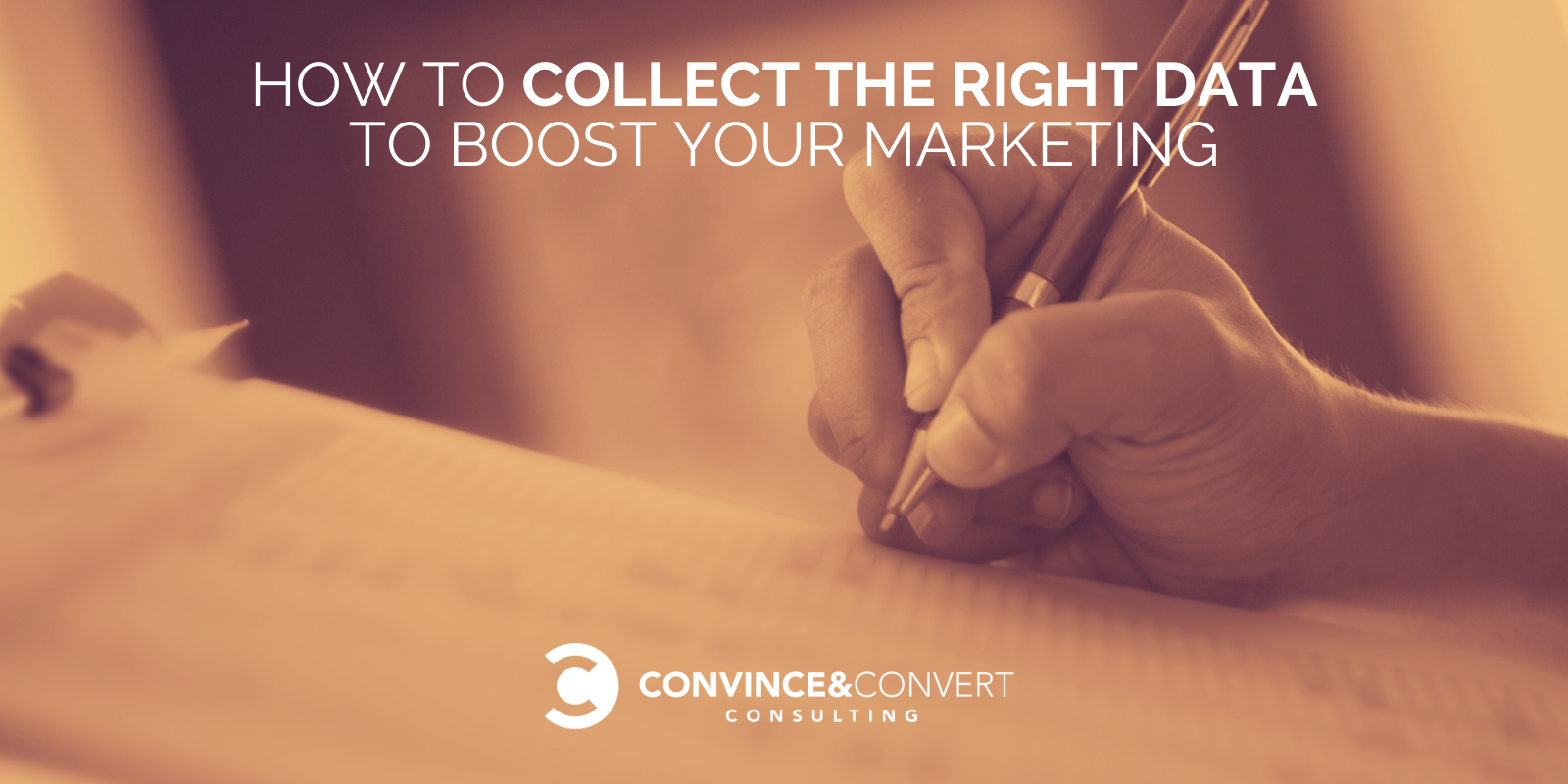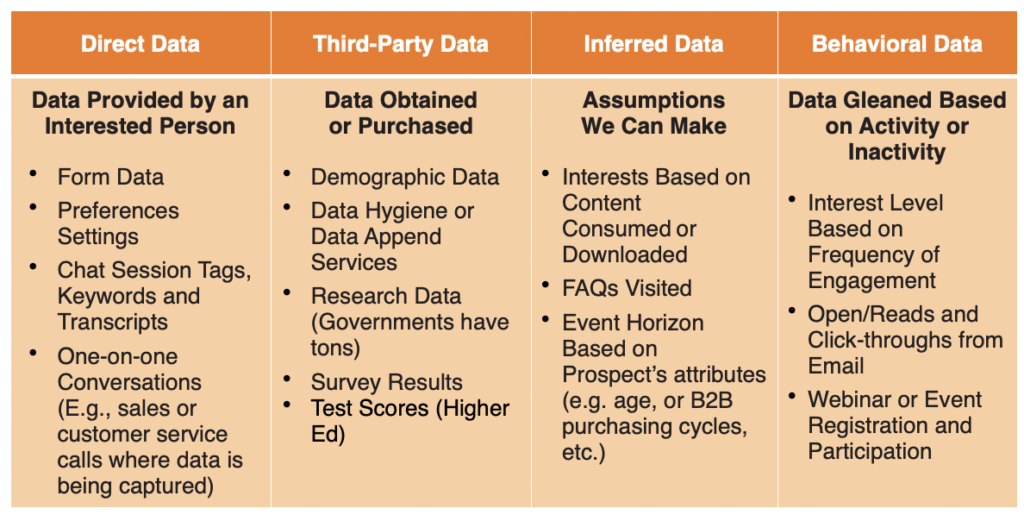
This is the second of a three-part series delving into the process for selection and preparation for CRM + marketing automation implementation.
In this installment, we delve deeper into the importance of data, the four categories of data, and how this will cause you to rethink your CTAs and webforms.
In the first series in this installment, I explained how to choose a marketing automation platform and the four essential pillars needed to support an effective marketing automation plan. The first pillar was data. To elaborate on that, given all the attention and resources applied to the collection and analysis of data, one would think this is pretty well buttoned-up. But in practice, we often see major chasms across the data landscape.
For now, let’s narrow our focus to just the data collection that directly impacts marketing communications.
There is a litany of breakpoints we typically see, including things like:
- Poor Data Integrity—data that is not uniform in structure within the data collection points or once in the CRM system. That make using the data more difficult or ineffective.
- Poor Data Hygiene—data that is outdated, inaccurate, missing, or duplicated. Ask yourself when was the last time your prospect or customer data was screened to de-duplicate and consolidate records? It should be a regular, ongoing process, but too often, it is not.
- Data Silos—we see this one a lot (we’re looking at you Higher Ed institutions), where decentralized organizations aren’t well set-up to share and consolidate data, even though different divisions and departments have common goals. Ironically, smaller operations are usually better at this, often only one database of record for the entire enterprise. But as the size and complexity of the business increases, those bridges to and from the data silos are often overlooked or in disrepair.
- Data Apathy—which include records that aren’t updated with actions or inactions, source tracking on those engagements, no record of content consumed, and we won’t even start on lead scoring and attribution models. We’d need a whole new interview series on that.
The larger, all-encompassing CRM + MA platforms can do a pretty good job here. But we often see gaps in the implementation of those systems, or internal—misuse is maybe too strong a term—inconsistent procedures to maintain all the desired flows of data to and from external and internal systems.
If access to good data is such a foundational element, where should someone begin to sort that out?
Let’s start by taking a step back and looking at the types of data, of which there are four types or categories available. If your organization isn’t using data from all four categories, ask yourself, “Why aren’t we?”
Take a look at this table and add/edit/delete specific data points that are relevant to your organization. The categories will probably work as-is, but the specific bullet-point examples should reflect your current state, and ideally your desired future state.

Not every organization will need to exhaustively pursue every potential source of data, that’s not practical. The benefit of this exercise is to look at what data you collect now, how actionable is it, and is it being utilized to achieve an optimal outcome? If not, determine what additional data collections and data bridges need to be inserted into the process.
And optimal outcome means optimal for the customer or prospect, the sales, marketing and customer service teams, finance and management. When done correctly, everyone benefits.
Data is the key to relevancy.
And relevancy is the killer app!
—Jay Baer, Founder and CEO, Convince and Convert
Jay has espoused this truism from stages and keynote addresses across the country for the past several years, and it is still true today. I’ll paraphrase here:
Marketers all tell themselves a big lie. They tell themselves our prospects and customers are just too busy to read and consume all the fantastic marketing materials we make available to them.
And it’s just not true. We all have the exact same 24-hours in each day. What everyone does is prioritize how that time is spent. And when it comes to the consumption of marketing material, if it is not relevant here and now to that individual, it quickly plummets off any priority list. Data is the key to relevancy. And relevancy is the killer app! Good data is the linchpin for relevancy.
Why Good Data Collection Drives a Rethinking of Calls-to-Action and Form Design
Take an intentional backwards approach and begin with the desired future-state of what we envision our CRM + marketing automation should do.
It ties back to the “features and functional requirements” process we cover in the first part of this interview. But it’s data and content that are the keys!
As a simple example, recently, several clients wanted to introduce text messaging as part of their marketing automation channel expansion. But none of their lead-gen forms were set up to facilitate that. It’s a simple change, really. But they have to collect the data and permission before implementation is even possible. That’s why we work backwards—the data has to be acquired before the utilization of the data can ever materialize.
Another example we see too often: brands and organizations want to personalize emails with the first name of the recipient. But their data collection forms have only one field, labeled, “Name”. That’s a non-starter for the data integrity because you get an array of inconsistent input on that field.
- Sam
- Sammy
- Sammy Hagar
- Mr. and Mrs. Sammy Hagar
This should be an easy fix to make on the forms and within the database, and many others once you define what that desired future state looks like. And when you do it, go back through all the currently active records and update those fields accordingly. Always keep in mind data integrity and data continuity.
Updating Calls-to-Action for Data Collection
It’s not uncommon for the primary, or only CTA to be “Buy Now”, or, “Enroll Now,” or “Schedule an Appointment Now.” Basically, down-the-funnel CTAs that are premature in the upper stages of the customer journey.
We like to invent new, top-and middle- of the funnel CTAs that ease the prospect into the journey. We apply a bit of progressive disclosure to it and learn what is relevant to each prospect. That in turn allows us to home in on relevancy. It drives the marketing automation process, the conditional logic, the content created or offered. That data is at the core of everything and too few led-gen processes we see take advantage of this.
If you ask an interested prospect a few questions to help him/her get fewer communications from you and more relevant ones when they are sent, most people will buy into that. It’s analogous to dating. But that’s yet another interview.
We’ve got some great examples of how we introduce non-obvious CTAs, all new CTAs, that fundamentally changed the way a business looks at lead-gen.
In Part Three of this series:
The implementation journey is about to begin. But you are not ready. There is a lot that can and should be done before anyone starts loading software onto servers.
The post How to Collect the Right Data to Boost Your Marketing appeared first on Content Marketing Consulting and Social Media Strategy.
from Content Marketing Consulting and Social Media Strategy https://ift.tt/3f7IYdM

No comments:
Post a Comment